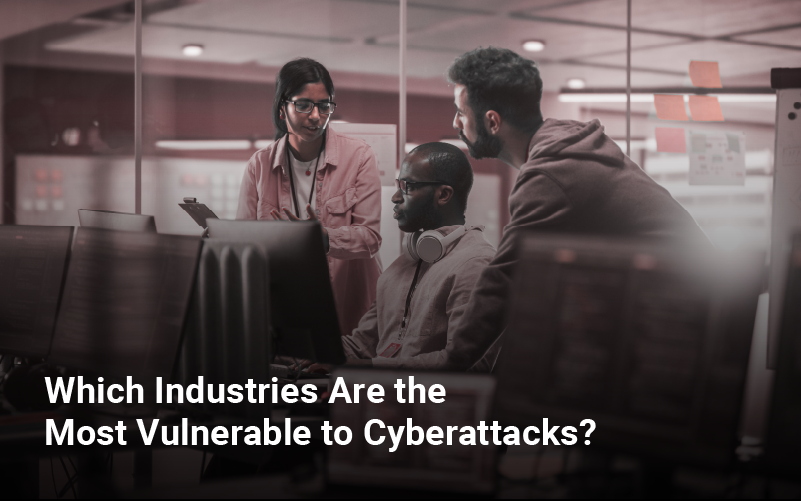Cyberattacks pose a significant challenge, threatening industries that house vast amounts of sensitive data. 72% of respondents mentioned that their companies received cyber threats in the past year (Statista, 2023)1. The ubiquity of data in several industries has opened the floodgate of cyberattacks, and cybercriminals have honed their skills at exploiting vulnerabilities. This blog delves into industries most susceptible to cyberattacks, supported by relevant statistics, shedding light on the gravity of the unfolding situation.
Industries Most Susceptible to Cyberattacks
Cyberattacks on companies with sensitive data reflect imminent danger. With the evolution and constant adaptation of IoT devices and digital data storage, some industries are at the highest risk of cyberattacks. The risk matrix of cyberattacks calls for an urgent need to safeguard their cybersecurity. Starting with the leading industry in the battle of cyberattacks.
1. Manufacturing: Industry 4.0 and the Cyber Challenge
Topped with the highest share of cybercrimes worldwide (Statista, 2023)2, the manufacturing sector is transforming with Industry 4.0. However, this evolution comes with increased cyber risks. Integrating Internet of Things (IoT) devices and increased automation exposes manufacturers to new vulnerabilities. Cyberattacks can disrupt production lines, steal intellectual property, and compromise the integrity of the supply chain. Manufacturers must balance innovation with robust cybersecurity measures to secure operations against the evolving threat landscape.
2. Professional, Business and Consumer Services
Professional, business, and consumer services include a wide spectrum, including law firms, marketing agencies, consulting services, and more. Since these kinds of organizations work with data (often sensitive), they are a prime target for cybercriminals. A successful cyberattack on any of the segments in this sector may lead to financial loss, damage to brand identity, affect client trust, and lead to legal issues.
3. Healthcare Industry: A High-Stakes Target
The healthcare sector has become a prime target for cybercriminals. As per a study, the global healthcare cybersecurity market is projected to reach 35.3 billion by 2028, emphasizing the growing recognition of the sector’s vulnerability (Marketsandmarkets, 2023)1. With the accumulation of interconnected medical devices and Electronic Health Records (EHRs), cyberattacks in healthcare have severe consequences.
The interconnected nature of healthcare systems, combined with the lucrative value of medical records on the black market, highlights the urgent need for robust cybersecurity measures to safeguard patient data
4. Financial Services: A Persistent Battleground
The financial sector remains a perpetual battleground for cyberattacks, and it is projected that the rise of AI in banking and growth in real-time payments will make the finance sector prone to cyberattacks in 2024 (Deloitte, 2024). Financial institutions face multifaceted challenges with the rise of sophisticated threats, including Advanced Persistent Threats (APTs) and ransomware. The financial implications are substantial, but the potential erosion of customer trust and reputational damage are equally concerning. As the financial industry digitizes, investments in cutting-edge cybersecurity solutions are imperative to mitigate risks.
5. Energy and Utilities: Industrial Sector Under Siege
The energy and utilities of the Industrial sector are vital for powering nations. However, it is not immune to the escalating threat of cyberattacks. According to a study, the global energy cybersecurity market size will reach $21.8 billion by 2031 (Allied Market Research., 2023). The statistics underscore the dual nature of threats, encompassing financial losses and potential threats to national security. As cybercriminals target critical infrastructure, the need for comprehensive cybersecurity frameworks to safeguard against ransomware, data breaches, and state-sponsored attacks becomes paramount.
6. Retail and E-commerce: Digital Storefronts in the Crosshairs
The retail industry, particularly the burgeoning realm of e-commerce, is a favored target for cybercriminals seeking access to vast amounts of customer data.
This highlights the critical need for e-commerce platforms to fortify their defenses against data breaches that could result in significant financial losses. Beyond monetary implications, brand reputation and customer trust erosion further accentuate the urgency for robust cybersecurity measures in the retail sector.
In the face of an ever-evolving cyber landscape, industries must prioritize cybersecurity to protect sensitive data, maintain operational continuity, and preserve customer trust. The statistics clearly show the escalating financial stakes, underlining the imperative for proactive cybersecurity measures.
As healthcare, financial services, professionals, businesses and consumer services, energy and utilities, manufacturing, and retail navigate the digital frontier, investments in cutting-edge cybersecurity solutions are not just a choice but a necessity. Integrating cybersecurity into organizational strategies becomes pivotal for staying ahead of cyber threats in an interconnected world. It’s a collective responsibility to fortify the digital defenses and ensure the resilience of industries against the persistent and evolving threat of cyberattacks.
How Can EC-Council University Help Against Cyberattacks?
EC-Council University’s Master of Science in Cyber Security program is a pivotal asset for professionals seeking to address the pressing challenges faced by industries vulnerable to cyberattacks. This specialized course offers an in-depth curriculum that equips students with a profound understanding of cybersecurity principles. Also, it delves into eight advanced industry-recognized cybersecurity certifications. Integrating real-world case studies, hands-on practical exercises, and the latest industry trends enables students to develop a strategic approach to cybersecurity.
References:
Allied Market Research. (2023). Cyber Security in Energy Market 2023. | Allied Market Research
https://www.alliedmarketresearch.com/cyber-security-in-energy-market-A53491
Deloitte. (2024). 2024 Banking and Capital Markets Outlook. | Deloitte.
https://www2.deloitte.com/xe/en/insights/industry/financial-services/financial-services-industry-outlooks/banking-industry-outlook.html
1Marketsandmarkets. (2023). Healthcare Cybersecurity Market (2023). | Marketsandmarkets.
https://www.marketsandmarkets.com/Market-Reports/healthcare-cybersecurity-market-215097518.html
1 Statista. (2023). Threat of cyber attacks to global organizations 2023 | Statista
https://www.statista.com/statistics/1337538/threat-cyber-attacks-organizations-worldwide/
2 Statista. (2023) Share of cyber attacks in global industries worldwide 2022
https://www.statista.com/statistics/1315805/cyber-attacks-top-industries-worldwide/#:~:text=During%20the%20examined%20year%2C%20cyber,a%20share%20of%2014.6%20percent.








